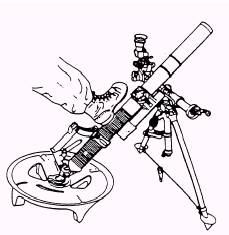|
MISFIRES A MISFIRE is a round that has been inserted in the mortar but has failed to
fire. A misfire is a complete failure to fire. It may be caused by a faulty
firing mechanism or a faulty element in the propelling charge explosive train.
A misfire in itself is not dangerous, but since it cannot be immediately distinguished
from a delay in functioning of the firing mechanism or from a hangfire, it must
be handled with care. Mechanical malfunctions may be caused by a faulty firing
pin,

Figure 14-21.-Misfire procedure: Dislodging the round.
rounds lodging in the barrel because of burrs, excess paint, oversize rounds,
or foreign matter in the tube. A HANGFIRE is a round that gets lodged in the
barrel for one reason or another, and the round does not strike the firing pin.
Thus a hangfire cannot be distinguished immediately from a misfire. Any round
that fails to fire should be treated as a misfire. When a firing malfunction
occurs, any member of the squad noticing that a misfire has occurred immediately
announces MISFIRE. When conditions permit, the mortar crew should wait approximately
1 minute before attempting to clear the misfire. This waiting period may avoid
an accident, caused by a delayed action of the ignition cartridge. If the barrel
is excessively hot, it should be cooled to avoid cooking off the misfire. Wet
sandbags or water or both maybe used to cool the mortar barrel. All persons
not actively engaged in clearing the misfire should be kept at a safe distance
until the misfire has been removed.
The above procedures are similar for both the conventional mode and the hand-held
mode. The major difference is the support needed for the M225 cannon, since
the hand-held mode is without a biped. Sandbags, empty ammo boxes, or anything
else that will furnish the required support may be used to maintain safe elevation
of the muzzle.
If a misfire occurs, the gunner sets the fire selector to the T (trigger) position
and squeezes the trigger twice to confirm the malfunction. If the weapon fails
to fire after the second try, any crew member noticing it announces MISFIRE.
The gunner changes the firing selector to the S (safe) position, and then kicks
the lower portion of the cannon (fig. 14-21). This is to dislodge

Figure 14-22.-Misfire procedure: Cooling the barrel.
the round. The gunner ensures the weapon is aimed down range, changes the fire
selector to T (trigger) position, then squeezes the trigger. The round should
fire. If it does not, he returns the selector to the S (safe) position and keeps
the muzzle elevated and pointed down range. He then allows the outer surface
to cool. This can be done by using water (fig. 14-22) or just allowing the air
to cool it until the cannon can be handled with bare hands. The gunner lifts
the base cap end (fig. 14-23) of the cannon, and the assistant gunner places
his hands around the outer edge of the muzzle. As the base cap end is lifted,
the round should slide out. The assistant gunner stops it with his thumbs, then
removes the round from the bore and places it in the designated area.
CAUTION
Never put your hands in front of the muzzle.
|

